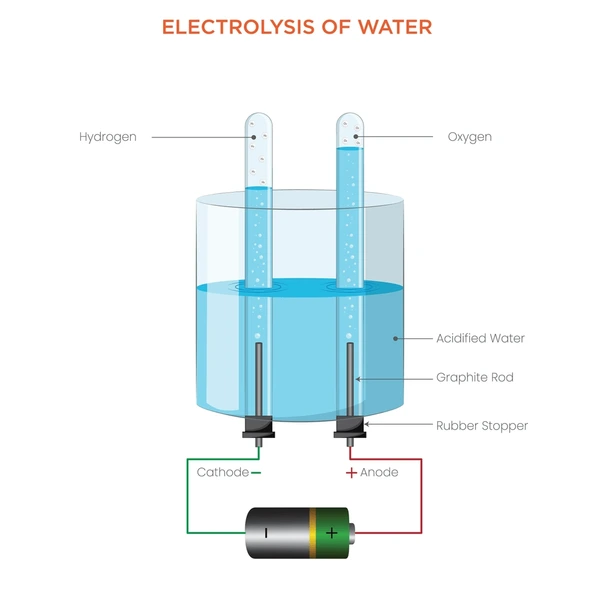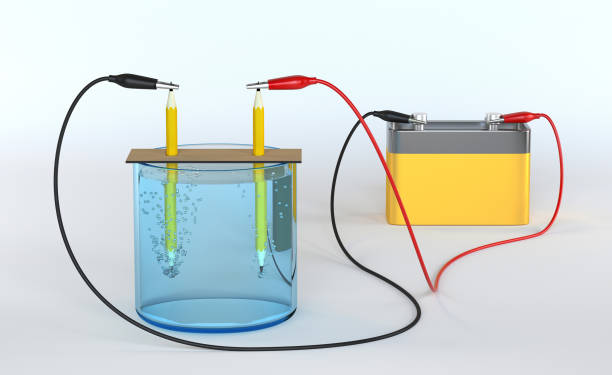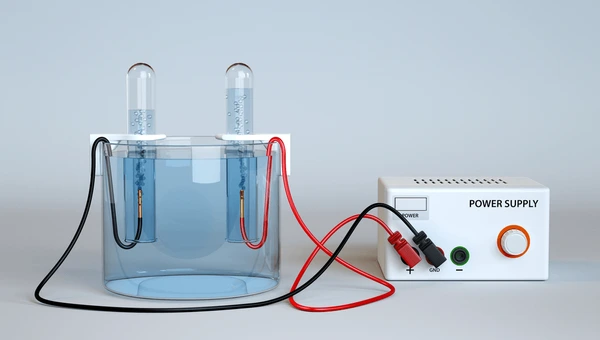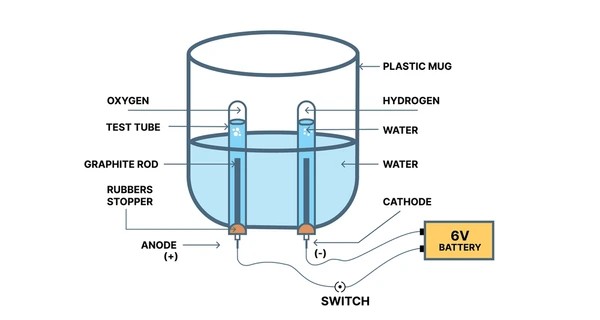The electrolysis of water is a fundamental process in both industrial chemistry and green energy technology. It offers a clean and efficient way to produce hydrogen gas, which is increasingly vital in fueling a carbon-neutral future. In this comprehensive guide, we examine every essential detail of water electrolysis from its core principles to real-world applications.
Introduction to Electrolysis of Water
Electrolysis of water is a chemical process that uses an electric current to split water (H₂O) into its basic elements of hydrogen (H₂) and oxygen (O₂). This reaction occurs in an electrolytic cell and requires an electrolyte to facilitate ion movement.
The overall reaction is:
2H₂O (l) → 2H₂ (g) + O₂ (g)

This process is non-spontaneous and requires energy input, usually provided by direct current (DC) electricity.
Principles Behind the Process
Electrolysis of water operates on the basic principles of redox (reduction-oxidation) reactions. When electric current flows through water containing an electrolyte, it triggers two simultaneous half-reactions at the electrodes:
- At the cathode (negative electrode): Reduction of hydrogen ions:
2H⁺ + 2e⁻ → H₂ (g) - At the anode (positive electrode): Oxidation of hydroxide ions:
4OH⁻ → O₂ (g) + 2H₂O + 4e⁻
These half-reactions occur in an aqueous solution, where an electrolyte such as dilute sulfuric acid (H₂SO₄) or potassium hydroxide (KOH) improves conductivity.
Types of Electrolysis Cells

1. Alkaline Electrolyzers
These use an alkaline electrolyte like KOH or NaOH. They are cost-effective and widely used in industrial hydrogen production.
2. PEM Electrolyzers (Proton Exchange Membrane)
These utilize a solid polymer electrolyte. They are compact, efficient, and suitable for renewable energy sources like solar and wind.
3. Solid Oxide Electrolyzers
These operate at high temperatures (around 700–1000°C). They offer higher efficiency but are more complex and costly.
Materials Required for Electrolysis of Water
- Electrolyte: Dilute sulfuric acid, sodium hydroxide, or salt.
- Electrodes: Generally inert materials like platinum, graphite, or stainless steel.
- Power Supply: A DC power source (such as a battery or regulated power supply).
- Apparatus: Electrolytic cell (can be a beaker), connecting wires, and a voltmeter.
Detailed Step-by-Step Procedure
1. Preparing the Electrolyte Solution
Fill a beaker with distilled water and add a small amount of dilute sulfuric acid or sodium hydroxide to increase conductivity.
2. Setting Up Electrodes

Insert two inert electrodes into the electrolyte, ensuring they do not touch. Attach wires from the DC power supply to the electrodes positive to the anode and negative to the cathode.
3. Initiating Electrolysis
Turn on the power supply. Bubbles will form at both electrodes of hydrogen gas at the cathode and oxygen gas at the anode.
4. Collecting Gases
Use inverted test tubes or gas-collection syringes to capture the gases. The volume of hydrogen collected should be approximately twice that of oxygen.
Balanced Chemical Equations
Cathode (Reduction):
2H⁺ + 2e⁻ → H₂ (g)
Anode (Oxidation):
2H₂O → O₂ (g) + 4H⁺ + 4e⁻
Overall Reaction:
2H₂O (l) → 2H₂ (g) + O₂ (g)
This stoichiometric relationship confirms that two molecules of hydrogen are produced for every molecule of oxygen.
Applications of Water Electrolysis
1. Hydrogen Fuel Production
Hydrogen obtained from electrolysis is a clean, renewable fuel source. It powers hydrogen fuel cells, which are used in electric vehicles, drones, and spacecraft.
2. Oxygen Supply
The oxygen generated during electrolysis is used in medical applications, welding, and aerospace operations.
3. Industrial Synthesis
Hydrogen is a vital reactant in Haber’s process (for ammonia synthesis) and in hydrocracking processes in petrochemical industries.
Advantages of Electrolysis
- Eco-Friendly: Produces green hydrogen with zero carbon emissions when powered by renewable energy.
- High Purity Gases: Both hydrogen and oxygen are generated in pure form.
- Scalable: Suitable for both small-scale labs and large-scale industrial production.
Challenges in Water Electrolysis

- High Energy Consumption: Requires a significant input of electrical energy, affecting economic viability.
- Electrode Degradation: Electrodes may wear out over time, especially under high-voltage operations.
- Cost of Electrolyzers: Although PEM electrolyzers are efficient, they are costly because they use rare and expensive materials such as platinum.
Enhancing Efficiency in Electrolysis
- Using Catalysts: Materials like nickel, iridium oxide, or platinum improve reaction rates.
- Optimal Voltage Application: Applying just enough voltage (above 1.23 V) avoids excessive heat loss.
- Temperature Control: Elevated temperatures can increase reaction efficiency but must be carefully managed.
Recent Innovations in Water Electrolysis
- Artificial Photosynthesis: Imitate nature splits water using solar energy directly.
- Low-Cost Catalysts: Development of abundant materials like manganese and cobalt for cost-effective hydrogen production.
- Integrated Systems: Coupling electrolyzers with solar panels and wind turbines for off-grid hydrogen generation.
Conclusion
The electrolysis of water stands as a cornerstone in modern chemistry and sustainable energy systems. Its ability to produce clean hydrogen fuel makes it a central technology in the fight against climate change. As research progresses and innovations continue, water electrolysis is poised to become more efficient, economical, and widespread, transforming industries and powering the future.
What is the electrolysis of water?
The electrolysis of water is a fundamental process in both industrial chemistry and green energy technology. It offers a clean and efficient way to produce hydrogen gas, which is increasingly vital in fueling a carbon-neutral future. In this comprehensive guide, we examine every essential detail of water electrolysis from its core principles to real-world applications.
What is Electrolysis of Water?
Electrolysis of water is a chemical process that uses an electric current to split water (H₂O) into its basic elements of hydrogen (H₂) and oxygen (O₂). This reaction occurs in an electrolytic cell and requires an electrolyte to facilitate ion movement.
The overall reaction is:
2H₂O (l) → 2H₂ (g) + O₂ (g)

This process is non-spontaneous and requires energy input, usually provided by direct current (DC) electricity.
Principles Behind the Process
Electrolysis of water operates on the basic principles of redox (reduction-oxidation) reactions. When electric current flows through water containing an electrolyte, it triggers two simultaneous half-reactions at the electrodes:
At the cathode (negative electrode): Reduction of hydrogen ions:
2H⁺ + 2e⁻ → H₂ (g)
At the anode (positive electrode): Oxidation of hydroxide ions:
4OH⁻ → O₂ (g) + 2H₂O + 4e⁻
These half-reactions occur in an aqueous solution, where an electrolyte such as dilute sulfuric acid (H₂SO₄) or potassium hydroxide (KOH) improves conductivity.
Types of Electrolysis Cells

1. Alkaline Electrolyzers
These use an alkaline electrolyte like KOH or NaOH. They are cost-effective and widely used in industrial hydrogen production.
2. PEM Electrolyzers (Proton Exchange Membrane)
These utilize a solid polymer electrolyte. They are compact, efficient, and suitable for renewable energy sources like solar and wind.
3. Solid Oxide Electrolyzers
These operate at high temperatures (around 700–1000°C). They offer higher efficiency but are more complex and costly.
Materials Required for Electrolysis of Water
Electrolyte: Dilute sulfuric acid, sodium hydroxide, or salt.
Electrodes: Generally inert materials like platinum, graphite, or stainless steel.
Power Supply: A DC power source (such as a battery or regulated power supply).
Apparatus: Electrolytic cell (can be a beaker), connecting wires, and a voltmeter.
Detailed Step-by-Step Procedure
1. Preparing the Electrolyte Solution
Fill a beaker with distilled water and add a small amount of dilute sulfuric acid or sodium hydroxide to increase conductivity.
2. Setting Up Electrodes

Insert two inert electrodes into the electrolyte, ensuring they do not touch. Attach wires from the DC power supply to the electrodes positive to the anode and negative to the cathode.
3. Initiating Electrolysis
Turn on the power supply. Bubbles will form at both electrodes of hydrogen gas at the cathode and oxygen gas at the anode.
4. Collecting Gases
Use inverted test tubes or gas-collection syringes to capture the gases. The volume of hydrogen collected should be approximately twice that of oxygen.
Balanced Chemical Equations
Cathode (Reduction):
2H⁺ + 2e⁻ → H₂ (g)
Anode (Oxidation):
2H₂O → O₂ (g) + 4H⁺ + 4e⁻
Overall Reaction:
2H₂O (l) → 2H₂ (g) + O₂ (g)
This stoichiometric relationship confirms that two molecules of hydrogen are produced for every molecule of oxygen.
Applications of Water Electrolysis
1. Hydrogen Fuel Production
Hydrogen obtained from electrolysis is a clean, renewable fuel source. It powers hydrogen fuel cells, which are used in electric vehicles, drones, and spacecraft.
2. Oxygen Supply
The oxygen generated during electrolysis is used in medical applications, welding, and aerospace operations.
3. Industrial Synthesis
Hydrogen is a vital reactant in Haber’s process (for ammonia synthesis) and in hydrocracking processes in petrochemical industries.
Advantages of Electrolysis
Eco-Friendly: Produces green hydrogen with zero carbon emissions when powered by renewable energy.
High Purity Gases: Both hydrogen and oxygen are generated in pure form.
Scalable: Suitable for both small-scale labs and large-scale industrial production.
Challenges in Water Electrolysis

Electrolysis of Water
High Energy Consumption: Requires a significant input of electrical energy, affecting economic viability.
Electrode Degradation: Electrodes may wear out over time, especially under high-voltage operations.
Cost of Electrolyzers: Although PEM electrolyzers are efficient, they are costly because they use rare and expensive materials such as platinum.
Enhancing Efficiency in Electrolysis
Using Catalysts: Materials like nickel, iridium oxide, or platinum improve reaction rates.
Optimal Voltage Application: Applying just enough voltage (above 1.23 V) avoids excessive heat loss.
Temperature Control: Elevated temperatures can increase reaction efficiency but must be carefully managed.
Recent Innovations in Water Electrolysis
Artificial Photosynthesis: Imitate nature splits water using solar energy directly.
Low-Cost Catalysts: Development of abundant materials like manganese and cobalt for cost-effective hydrogen production.
Integrated Systems: Coupling electrolyzers with solar panels and wind turbines for off-grid hydrogen generation.
Conclusion
The electrolysis of water stands as a cornerstone in modern chemistry and sustainable energy systems. Its ability to produce clean hydrogen fuel makes it a central technology in the fight against climate change. As research progresses and innovations continue, water electrolysis is poised to become more efficient, economical, and widespread transforming industries and powering the future.
Is distilled water alone sufficient for electrolysis of water?
Why is hydrogen collected in larger amounts than oxygen?
Can electrolysis be used for drinking water purification?
Explain the electrolysis of water.
The electrolysis of water is a fundamental process in both industrial chemistry and green energy technology. It offers a clean and efficient way to produce hydrogen gas, which is increasingly vital in fueling a carbon-neutral future. In this comprehensive guide, we examine every essential detail of water electrolysis from its core principles to real-world applications.
What is Electrolysis of Water?
Electrolysis of water is a chemical process that uses an electric current to split water (H₂O) into its basic elements of hydrogen (H₂) and oxygen (O₂). This reaction occurs in an electrolytic cell and requires an electrolyte to facilitate ion movement.
The overall reaction is:
2H₂O (l) → 2H₂ (g) + O₂ (g)

This process is non-spontaneous and requires energy input, usually provided by direct current (DC) electricity.
Principles Behind the Process
Electrolysis of water operates on the basic principles of redox (reduction-oxidation) reactions. When electric current flows through water containing an electrolyte, it triggers two simultaneous half-reactions at the electrodes:
At the cathode (negative electrode): Reduction of hydrogen ions:
2H⁺ + 2e⁻ → H₂ (g)
At the anode (positive electrode): Oxidation of hydroxide ions:
4OH⁻ → O₂ (g) + 2H₂O + 4e⁻
These half-reactions occur in an aqueous solution, where an electrolyte such as dilute sulfuric acid (H₂SO₄) or potassium hydroxide (KOH) improves conductivity.
Types of Electrolysis Cells

Electrolysis of Water
1. Alkaline Electrolyzers
These use an alkaline electrolyte like KOH or NaOH. They are cost-effective and widely used in industrial hydrogen production.
2. PEM Electrolyzers (Proton Exchange Membrane)
These utilize a solid polymer electrolyte. They are compact, efficient, and suitable for renewable energy sources like solar and wind.
3. Solid Oxide Electrolyzers
These operate at high temperatures (around 700–1000°C). They offer higher efficiency but are more complex and costly.
Materials Required for Electrolysis of Water
Electrolyte: Dilute sulfuric acid, sodium hydroxide, or salt.
Electrodes: Generally inert materials like platinum, graphite, or stainless steel.
Power Supply: A DC power source (such as a battery or regulated power supply).
Apparatus: Electrolytic cell (can be a beaker), connecting wires, and a voltmeter.
Detailed Step-by-Step Procedure
1. Preparing the Electrolyte Solution
Fill a beaker with distilled water and add a small amount of dilute sulfuric acid or sodium hydroxide to increase conductivity.
2. Setting Up Electrodes

Insert two inert electrodes into the electrolyte, ensuring they do not touch. Attach wires from the DC power supply to the electrodes positive to the anode and negative to the cathode.
3. Initiating Electrolysis
Turn on the power supply. Bubbles will form at both electrodes of hydrogen gas at the cathode and oxygen gas at the anode.
4. Collecting Gases
Use inverted test tubes or gas-collection syringes to capture the gases. The volume of hydrogen collected should be approximately twice that of oxygen.
Balanced Chemical Equations
Cathode (Reduction):
2H⁺ + 2e⁻ → H₂ (g)
Anode (Oxidation):
2H₂O → O₂ (g) + 4H⁺ + 4e⁻
Overall Reaction:
2H₂O (l) → 2H₂ (g) + O₂ (g)
This stoichiometric relationship confirms that two molecules of hydrogen are produced for every molecule of oxygen.
Applications of Water Electrolysis
1. Hydrogen Fuel Production
Hydrogen obtained from electrolysis is a clean, renewable fuel source. It powers hydrogen fuel cells, which are used in electric vehicles, drones, and spacecraft.
2. Oxygen Supply
The oxygen generated during electrolysis is used in medical applications, welding, and aerospace operations.
3. Industrial Synthesis
Hydrogen is a vital reactant in Haber’s process (for ammonia synthesis) and in hydrocracking processes in petrochemical industries.
Advantages of Electrolysis
Eco-Friendly: Produces green hydrogen with zero carbon emissions when powered by renewable energy.
High Purity Gases: Both hydrogen and oxygen are generated in pure form.
Scalable: Suitable for both small-scale labs and large-scale industrial production.
Challenges in Water Electrolysis

Electrolysis of Water
High Energy Consumption: Requires a significant input of electrical energy, affecting economic viability.
Electrode Degradation: Electrodes may wear out over time, especially under high-voltage operations.
Cost of Electrolyzers: Although PEM electrolyzers are efficient, they are costly because they use rare and expensive materials such as platinum.
Enhancing Efficiency in Electrolysis
Using Catalysts: Materials like nickel, iridium oxide, or platinum improve reaction rates.
Optimal Voltage Application: Applying just enough voltage (above 1.23 V) avoids excessive heat loss.
Temperature Control: Elevated temperatures can increase reaction efficiency but must be carefully managed.
Recent Innovations in Electrolysis of Water
Artificial Photosynthesis: Imitate nature splits water using solar energy directly.
Low-Cost Catalysts: Development of abundant materials like manganese and cobalt for cost-effective hydrogen production.
Integrated Systems: Coupling electrolyzers with solar panels and wind turbines for off-grid hydrogen generation.
Conclusion
The electrolysis of water stands as a cornerstone in modern chemistry and sustainable energy systems. Its ability to produce clean hydrogen fuel makes it a central technology in the fight against climate change. As research progresses and innovations continue, water electrolysis is poised to become more efficient, economical, and widespread transforming industries and powering the future.
What are the applications of electrolysis of water?
Applications of Electrolysis of Water
1. Hydrogen Fuel Production
Hydrogen obtained from electrolysis is a clean, renewable fuel source. It powers hydrogen fuel cells, which are used in electric vehicles, drones, and spacecraft.
2. Oxygen Supply
The oxygen generated during electrolysis is used in medical applications, welding, and aerospace operations.
3. Industrial Synthesis
Hydrogen is a vital reactant in Haber’s process (for ammonia synthesis) and in hydrocracking processes in petrochemical industries.
Advantages of Electrolysis
Eco-Friendly: Produces green hydrogen with zero carbon emissions when powered by renewable energy.
High Purity Gases: Both hydrogen and oxygen are generated in pure form.
Scalable: Suitable for both small-scale labs and large-scale industrial production.
Challenges in Electrolysis of Water

High Energy Consumption: Requires a significant input of electrical energy, affecting economic viability.
Electrode Degradation: Electrodes may wear out over time, especially under high-voltage operations.
Cost of Electrolyzers: Although PEM electrolyzers are efficient, they are costly because they use rare and expensive materials such as platinum.
Enhancing Efficiency in Electrolysis
Using Catalysts: Materials like nickel, iridium oxide, or platinum improve reaction rates.
Optimal Voltage Application: Applying just enough voltage (above 1.23 V) avoids excessive heat loss.
Temperature Control: Elevated temperatures can increase reaction efficiency but must be carefully managed.
Recent Innovations in Electrolysis of Water
Artificial Photosynthesis: Imitate nature splits water using solar energy directly.
Low-Cost Catalysts: Development of abundant materials like manganese and cobalt for cost-effective hydrogen production.
Integrated Systems: Coupling electrolyzers with solar panels and wind turbines for off-grid hydrogen generation.
1 thought on “Electrolysis of Water”